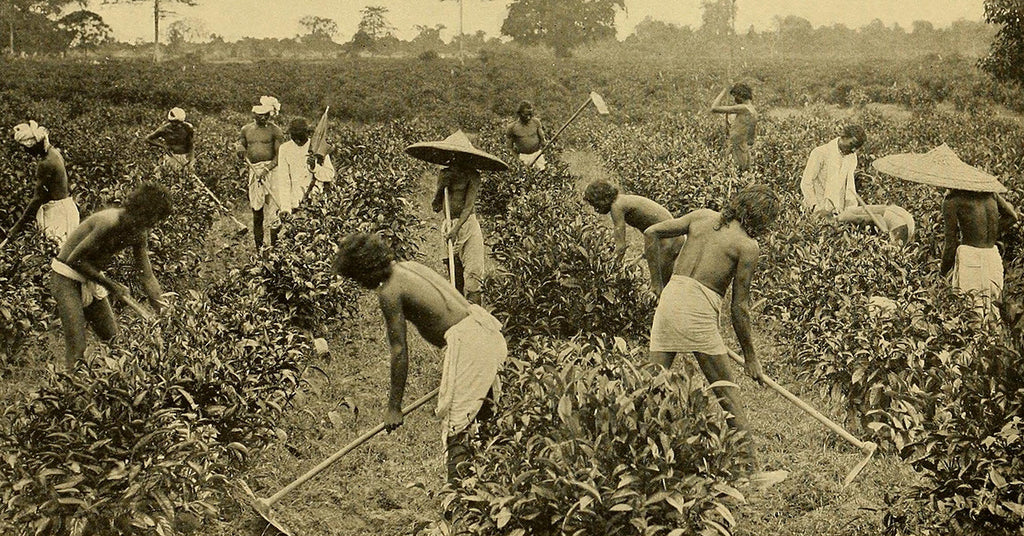Assam Tea’s Twisted History

Our host’s nephew swings off his motorcycle with a flourish, eager to deliver the shocking news. He jogs across the courtyard to join our group, a collection of American tea professionals visiting Dibrugarh, Assam on our guided India Tea Tour. The thick humid air is mixing with the smoke that’s warding off the attacking mosquitos on our last night in India's most prolific tea region. Without an introduction, he delivers the bombshell: India’s national government has declared that almost all commonly used currency has no value, effective immediately.
Since the majority of all transactions across India happen in cash, chaos is guaranteed to erupt in the morning. Thinking about the $1,000 in now-worthless bills tucked in my suitcase, my heart races as I consider tomorrow’s journey back to Kolkata.
Yet even though the peace of the night has been shattered, I find myself reveling at how India exists in a state of perpetual reinvention. This overnight transformation of the country’s entire economy gives me unexpected hope for Assam, because as this trip has so clearly illuminated, there’s much about India’s largest tea producing region that stands to be improved.
The next morning, as we load our luggage into the jeep to take us to the airport, the courtyard is buzzing with people associated with our host’s' various businesses. It’s a fittingly bizarre finish to our visit to Assam. From being hosted by a business tycoon who seemed more mob boss than tea planter to repeatedly being forced out of our car at checkpoints by young army officials carrying automatic rifles, it’s been a profoundly informative week.

Where Was Tea First Grown?
Deep in these jungles, the tea plant has thrived for as long as written records exist. Since Assam is just across the Himalayas from China’s Yunnan province, many debate whether the tea plant first grew in China or India. While it’s widely accepted that farmers in Yunnan were the first to intentionally cultivate the tea bush, there’s evidence to suggest that the Singpho tribes of Assam have been wild harvesting the plant and chewing on the leaves for as long as the Chinese have steeping them in hot water.
Part of what makes Assam so volatile is its richness of natural resources and strategic location, which has made it a thoroughfare for competing interests. Nestled between Bhutan to the west, China to the north, Myanmar (formerly Burma) to the east, and Bangladesh to the south, Assam sits at the confluence of landscape and cultures.
The defining feature of the region is the Brahmaputra River, a massive river that spills out of the Himalayas and brings fresh water into the low-lying valley of Assam. This natural source of fresh water gave rise to incredibly lush tropical jungles that are one of the last wild habitats for Asian elephants and also the home of the famed one-horned rhino that has become Assam tea’s official mascot.
The British Empire and Opium
While tea has existed in Assam for centuries, the crop didn’t take off until the British entered the scene in the early 1800s. At that point, tea had become the national drink of England, and the British sourced it exclusively from China. The tea trade was central to financing Britain's empire building. At one point, tea accounted for 10% of all the Crown’s earnings.
Despite the fortunes involved, the Chinese Emperor was fiercely opposed to trade with European merchants—he viewed them as a lower class of humans than the Chinese. To keep the invaluable trade going, the British turned to a far more addictive stimulant than caffeine: opium. Made from poppies grown in India, the British used black market tactics to introduce the wildly addictive drug up and down the Chinese coast, leading to massive amounts of Chinese men falling prey to the drug. The trade relations between the British and Chinese went from bad to toxic, dissolving into what is now known as the Opium Wars.
Meanwhile in India, as the two global superpowers were going to war, two Scottish brothers were busy laying the foundation for the Indian tea industry. Robert Bruce, an adventurer, was trading in Assam in 1823 when he learned of the wild tea plants that the local Singpho harvested. A local nobleman directed him to a local Singpho chief, who provided him with samples of the leaves and seeds. Robert died soon after that trip, but before that he briefed his brother Charles, an army soldier, on his Assam tea explorations. Charles took the work forward and by 1835, as it was clear Britain’s supply of Chinese tea was in jeopardy. The British declared the presence of tea “...by far the most important and valuable that has ever been made in matters connected with the agricultural or commercial resources of this empire.”
This Indian Tea Region's Darkest Hour
To expand their colonial powers, the British had begun to annex parts of Assam by encouraging wars between the various indigenous groups and taking land from the winners. With the realization that tea could be grown in Assam, they accelerated their work to strip tribal people of land rights through a series of backhanded policies and intimidation. They cross-pollinated the native Assam tea plants with those from China, and then, less than two decades after Robert Bruce bought tea from the Singpho, the first chests of Assam tea were sold at auction in London in 1838.

Though the tea was not very good, it opened the eyes of English investors to the untold fortunes that could await in India, a closer and more easily controlled supplier than the tea gardens of China. The Assam Company was formed by a group of London businessmen. Meanwhile in Assam, the Singpho began to pull away from helping the British, as it became increasingly clear to them that the Brit's obsession with tea was fueled by an extractive greed. The resulting labor shortage triggered one of the darkest chapters in labor history of the modern world.
British agents traveled to the surrounding states of Orissa, Bihar, Bengal, and Madhya Pradesh, recruiting from overpopulated and poor rural communities. They tricked illiterate farmers into signing themselves into indentured servitude and carted them all to Calcutta (now Kolkata). After being corralled into pens on the docks, they were sent up the Brahmaputra River in boats stuffed with humans and diseases. Cholera, malaria, and typhoid fever wreaked havoc, with thousands of workers dying before ever reaching Assam.
Those who survived the journey were greeted by whip-bearing plantation managers. They were immediately put to work clearing the vast jungles teeming with king cobras, tigers, and the countless diseases carried by the ever-present mosquitos. Underpaid and underfed, they were trapped far from their homes with no way out. In three years, it was estimated that almost 40% of the workforce brought to Assam died.
The Explosion of Assam Black Tea
Yet nothing could stop the advance of Assam loose-leaf tea. The British were the first to adapt developments from the Industrial Revolution, mechanizing much of the labor-intensive aspects of cultivating and processing the tea plant. In comparison to growing tea in the far reaches of mountains, the low elevation of Assam, with its tropical environment and rich fertile soils, allowed for prolific productivity. The British took these ideal conditions and optimized efficiency and consistency at every point, allowing Indian teas to outpace China within just four decades of the first gardens being established.
This model was soon exported to other parts of India and then across the globe, including Africa, South America, and southeast Asia. Today, Assam continues to be the world’s largest tea producing region, and its teas are commonly used to make English Breakfast, Earl Grey, and the strongest versions of chai.
Assam Tea's Future
As a mission-driven company advocating for rural tea makers, determining how best to engage with Assam has been one of the more complicated decisions we’ve had to make. Assam teas have become so ubiquitous today that it wouldn’t be possible to be a viable Indian tea importing company without selling Assam black teas. Plus, there are many strong practices that have been honed in Assam that aren’t extractive, practices that we want to support and encourage.
At the same time, tea drinkers in the US have clearly defined expectations for Assam’s specific bold taste and low prices. Assam’s lower elevation is great for making strong, punchy black teas, but for the complex nuanced specialty teas, tea makers must be willing to take creative leaps of faith, which are often risky. This makes it difficult for experimental small tea makers to compete with the massive corporations churning out millions of kilos of commodity tea annually.
Despite these challenges, a number of forward-thinking pioneers are emerging in Assam. One such pioneer is Tea Promoters of India (TPI), our exclusive Assam supplier. TPI, which is run by Indians and not interests from abroad, is one of the first companies in Assam to reinvent a post-colonial model of tea. Their efforts pre-date the fair trade concept, and, in fact, fair trade certifiers have based their standards off of practices that began at TPI’s gardens. TPI has a tradition of purchasing traditionally colonial tea gardens, then reviving them in a way that benefits local people and soils. In 2015, they purchased Assam's Chardwar Estate tea garden, the source for the Assam black tea we now carry in our online shop.
Today, TPI is involved in creatively using Assam’s existing infrastructure to remake the industry from the inside out. But their work extends beyond Assam's borders. As one of several examples, they’ve taken our partners in Kumaon under their wing by helping develop supply chains to move teas from the remote Kumaon mountains to export. Seeing TPI in action, I’m reminded of my college studies in engineering, where we learned that systems are easier to change when working from the inside, rather than when it’s forced from the outside.
The day after India's demonetization in 2016 while driving to the Bagdogra airport, I think about Assam's complicated history and ponder what small part Young Mountain Tea could play in helping change its future. My meandering thoughts are interrupted by the blaring sounds of our car’s horn as our driver pushes his way through the long lines of people waiting to get into the bank to exchange their money. Experiencing change in action, I feel a swell of hope. Disruption is wildly inconvenient, yet it also opens up the possibility for new futures that were previously unimaginable.
Want to Learn More About Our Tea's Origins?
READ ABOUT OUR TEA PARTNERS IN SOUTHERN INDIA'S NILGIRIS
You might also enjoy:
- Cultivating Kumaon: The Story Behind Our Kumaon Tea Origins
- How Black Tea is Made
- The History of Tea in India
Blog Author:

Raj Vable, Founder
He has been confounded by the leaf since his first transcendental encounter with white tea in 2010. Three years later, he started Young Mountain Tea to bridge his budding tea obsession with his interest in traveling in the mountains and previous experience creating job opportunities in rural India. He revels in working across cultures and can be regularly found trying to get the rest of the team on board with another outlandish tea project. His favorite teas remain white, and he’s always searching for the next cup of magic.




Comments on this post (2)
This article offers a captivating exploration of Assam black tea’s history, highlighting its cultural significance and transformation through British colonialism. Great read!
— Right Angle Developers
Very informative and important piece of history of Assam tea industry because I belong to the tea garden labourers community.
— Mukti Prakash Tirkey